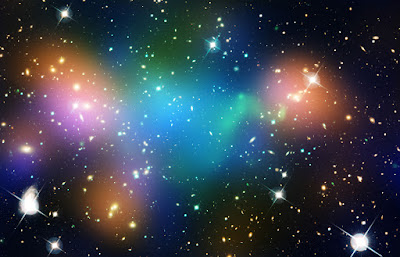The Strange Matter
Neutron
stars are the densest things that aren't black holes. In their cores, we'd find
the foremost dangerous substance in existence: Strange matter. A bizarre thing
so extreme, that it bends the principles of the universe and will infect and
destroy everything it comes into contact with or it could teach us about how
the universe began. Maybe both. to know how extreme strange matter really is,
we first got to get a couple of basics.
what's
a star , and the way does strange matter break the principles of the universe?
to urge all of this into one article, we'll grossly oversimplify a couple of
things, but we'll provide you with further reading if you would like more
details. A star is what remains after a really massive star explodes during a
supernova. When this happens, the star's core collapses under its own gravity
with such a robust inward force that it squeezes nuclei and particles together
violently. Electrons are pushed into protons, in order that they merge and
switch into neutrons. All the "nothing" inside atoms is suddenly
completely crammed with particles that basically don't need to be on the brink
of one another , but haven't any choice. They desperately keep off against
gravity, against the collapse. If gravity wins, they're going to become a
region . If they win, they become a star .
This
makes neutron stars like giant atomic nuclei the dimensions of a city, but
holding the mass of our Sun. And here, things get weird. The environment within
the core of neutron stars is so extreme that the principles of atomic physics
change. And this might cause a wierd and very dangerous substance. But let's
not get before ourselves. We first got to know the principles before we find
out how they will be broken. Protons and neutrons, the particles making up the
nuclei of atoms, are made from smaller particles called quarks. Quarks really
don't need to be alone. they're what we call confined. you'll attempt to
separate them, but the harder you pull, the harder they struggle to tug
themselves back together. If you employ tons of energy, they only use this
energy to make new quarks.
Quarks
only exist together because the building blocks of other particles and haven't
been observed by themselves. they are available in many sorts , but only two
appear to form stable matter: the 'up' and 'down' quarks found in protons and
neutrons. All other quarks seem to decay away quickly, but this might vary
inside neutron stars. The forces operating in their cores are so extreme that
they're actually almost like the universe shortly after the large Bang. star
cores are like fossils, which may allow us to peer back in time to the start of
everything. So learning how quarks behave inside a star may be a way of
understanding the very nature of the universe itself. One hypothesis is that,
inside a star core, protons and neutrons deconfine.
All
the particles crammed shoulder-to-shoulder dissolve and melt into a kind of
bath of quarks. Uncountable numbers of particles become one giant thing made
purely from quarks: Quark matter. A star made up of this is often called a
Quark Star. Though from the surface , it's going to not look any different than
a daily star . Now, we will finally mention the foremost dangerous substance.
If the pressure inside a quark star is great enough, it's going to get
stranger, literally. within the cores of neutron stars, a number of the quarks
could also be converted into 'strange' quarks.
Strangelets
Strange(
Strangelets ) quarks have bizarre nuclear properties, and that they are
heavier, and for the shortage of a far better word, stronger. If they happen ,
they might create strange matter. Strange matter could be the perfect state of
matter, perfectly dense, perfectly stable, indestructible, more stable than the
other matter within the universe. So stable that it can exist outside neutron
stars. If this is often the case, we've a drag . it'd be infectious. each piece
of matter it touches could be so impressed by its stability that it might
immediately become strange matter, too. Protons and neutrons would dissolve and
become a part of the quark bath, which frees energy and creates weirder matter.

So
Earth would freeze to death. And sort of a tiny virus, we'd haven't any thanks
to see a strangelet coming. Worse still, some theories suggest strangelets are
quite common, outnumbering all stars within the galaxy. The strangelets
could've formed very early after the Big Bang, when it was as hot and dense as
a neutron star core everywhere.
They
might be clumping around the gravity of galaxies as the universe expanded and
evolved. Strangelets could even be so numerous and large , that they could
actually be the substance we suspect holds galaxies together. But then again,
maybe not. This is speculation. And the Earth and Sun and planets haven't been
consumed during a wildfire of strangelets within the past few billion years.
So
the odds seem good that it won't happen any time soon. Understanding these
strange objects today may be the key to understanding the birth of our
universe, and why it grew to look the way it does now. When scientists first
started playing with magnets and wires and thinking about electrons, they had
no idea how technology would evolve in the next hundred years. The scientists
thinking about the cause of neutron stars and strange matter today may be
setting up humans for a future beyond our wildest imaginations ...or maybe not.
Time will tell.

Comments
Post a Comment
If you like my post then do follow & comment here.